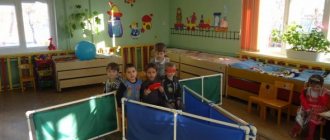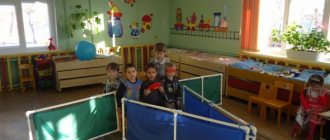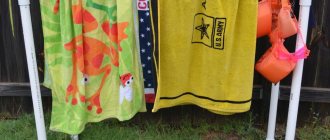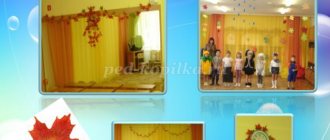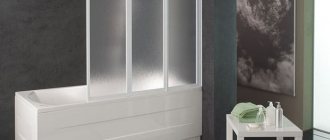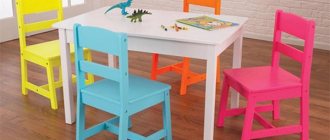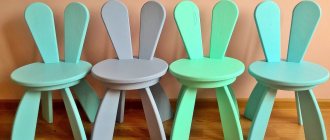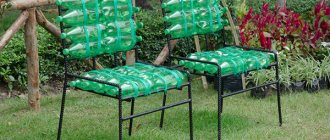The creative development of preschool children within the kindergarten is one of the important stages in the formation of a growing personality.
The group environment and surrounding objects promote curiosity, creativity, bold trials and discoveries.
Taking into account the fact that the child spends most of the daytime in a group, the surrounding space and interior in it become part of the gaming and educational process. The more opportunities children have to realize their own fantasies, the easier it is for a teacher to direct the learning process in the right direction.
The child treats objects and space as a resource, seeing in them opportunities for realizing his plans.
One of the interior details that can help in the creative development and organization of group life is a stylized screen. Being an important attribute of theatrical performances, with a touch of mystery, it evokes genuine delight and curiosity among children.
The simplest puppet theater attracts children much more than painted fictional characters.
Depending on the size, with the help of a screen you can stage scenes both for puppet theater and for real small actors, adding entertainment to the process and increasing interest.
The screen in this case becomes an urgently needed item.
If the group’s budget does not allow for purchasing a ready-made option, but the children have a desire to organize a theater club, you can make your own screen from plastic pipes for the kindergarten with your own hands.
The design of this multifunctional device is very simple.
Choosing design and sizes
Depending on the purpose of use and the age of the children, various designs can be made.
This could be a large full-length theatrical screen.
Or a small tabletop version of the screen to independently show scenes with puppet characters.
An important factor is the lightness and versatility of the design: children really appreciate the rare opportunity to independently change the arrangement of interior items, using them not as a mandatory established order, but as a resource for realizing ideas.
This develops management skills and also gives more space for play and creativity.
As a rule, the standard model of a screen made of PVC pipes is made with three sections.
It is enough to collect 3 frames, connect them together and cover them with beautifully decorated curtains.
However, this is not a mandatory rule, and if you wish and have the material, you can make a larger number of frame components. The design of the fabric stretched over the frame depends only on personal preferences - you can choose it together with your children from several options by making removable covers with Velcro fastenings.
When choosing covers, you can show your imagination and creativity.
Different colors of covers can be associated with seasons or themed holidays. For example, a green background in the spring, yellow and orange - with the onset of autumn, blue or dark blue - in the winter season.
There is a lot of room for imagination here for the teacher.
How to make a screen for a puppet theater
Floor screen
This puppet theater product takes up quite a lot of space and requires stability
. Such a screen can be installed in one of the kindergarten rooms by making dolls from plasticine, socks or soft toys. Children will definitely love playing with this screen.
To make a children's floor doll screen, you need to prepare the following materials:
- wooden blocks of the desired size;
- Styrofoam;
- nails;
- hammer;
- ruler;
- a simple pencil;
- stationery knife;
- foam;
- textile;
- scissors;
- decorative elements.
To put on a full-fledged theatrical performance, you need to bring all the elements together. Just follow the simple instructions :
- Measure the wooden blocks of the required size. This can be done using a pencil and ruler. You should pay attention to the height and width of the desired screen. Typically the height is about 100 cm.
- Use nails and a hammer to connect the bars together, making a window and legs for the floor theater screen.
- Use a utility knife to cut the same foam blocks. You can measure the bars using a ruler.
- Hot glue the foam onto the wooden blocks. This will create volume. If the master does not want to create additional volume and structure, this step can be skipped.
- Measure and cut a piece of fabric to cover the bars with. Foam rubber must be placed under the fabric.
- Sew a piece of fabric to the base. You can also glue it with hot glue.
- Cut another piece of fabric for the curtain. Attach to the window.
- Decorate the curtain with decorative elements.
After making such a floor toy for a puppet theater, you need to make the dolls with your own hands, and you can organize a theatrical performance.
Table screen
This type of product does not require much space and time to manufacture.
, it can be placed at home, ensuring the child’s development and interesting time spent with dolls. To make it you will need the following materials:
- cardboard box;
- scissors;
- a simple pencil;
- textile;
- threads;
- glue;
- decorative elements.
One of the options for making this toy is as follows:
- Cut the box on the edge. Make a stage for a screen from one face of a cube or parallelepiped. To do this, you need to measure approximately 5 cm on the left, right and top. Measure 7–10 cm from the bottom. Cut a window.
- Cut a cloud from the second edge. You can make a sketch with a simple pencil if necessary. The top of the stage should be decorated with a cloud.
- Make a base from the third face. It could be a semicircle. Paste a scene with a cloud on it.
- Make a curtain from a piece of fabric. Finish the edges of the curtain with threads for a neat look.
- Attach the curtain to the window. You can sew the materials together, or you can use glue.
- Decorate the box with decorative elements.
The design of such a table screen is limited only by the imagination of the master . You can use self-adhesive paper, beads and rhinestones. Children can help with decorating, it will bring them a lot of fun.
Materials and tools
Making a screen from plastic pipes with your own hands will not require large expenses. You will need propylene pipes of various lengths, plastic corners and double-sided fasteners to connect the sections to each other.
It is necessary to think through the design and calculate the amount of material.
All this can be taken after a recent renovation, or purchased at any specialized store for repairs.
The pipes are connected to each other using a plastic corner.
The sections are connected to each other with special double fasteners.
A special machine for welding plastic pipes made of propylene, which is used by professional plumbers during installation, can be a good help.
If you have nowhere to borrow it, you can also use the conventional heating method over the stove.
If desired, PVC pipes can be painted. For durability, you should use a mixture of putty and regular gouache.
Various ways to use multifunctional screens in kindergarten are suggested by the children themselves.
You can use any available fabric to sew covers. It must be remembered that it must be durable and easy to wash, since children's games are fraught with various consequences for any furniture, and the screen will not be an exception.
It is best to choose a bright and colorful material.
Depending on the design, you may need Velcro fasteners, ribbons or cords for garters, additional material for pockets or loops, and reliable adhesive.
Thanks to the principle of accessibility, children have the opportunity to independently change the space in their group at any time.
Premiere is coming
A home puppet theater is a great birthday gift for a baby. You can show your child your favorite fairy tale, and if you wish, make him the main character of your play. And for everything to be natural, you need to make a screen with your own hands.
Expert opinion
Soloviev Pavel Viktorovich
Designer with many years of experience and experience.
If you follow fashion trends, shadow theater is a novelty. We will try to build a screen for a shadow theater. Make a hole in the middle and the screen will instantly transform.
Necessary materials:
- chipboard sheet;
- drill;
- glue;
- scissors;
- electric jigsaw or hacksaw;
- small awnings;
- self-tapping screws;
- screwdriver;
- a simple pencil;
- measuring tape;
- sandpaper;
- Velcro;
- small autonomous flashlights;
- acrylic paints;
- brushes;
- decorative elements.
Step-by-step description of the process:
- You can take an old and unnecessary sheet of chipboard; after decorating, its imperfections will not be visible.
- So, we measure the same distance on all sides and draw a rectangle.
- For the side sashes, you can take leftover laminate or boards.
- Cut out two pieces of equal width and height.
- To cut a window in a sheet of chipboard, make holes in the four corners with a drill.
- Now it will be easy to carefully cut out the middle using a hacksaw or jigsaw.
- We process the chipboard sheet with sandpaper to eliminate all roughness.
- At this stage, the main part of the structure can be painted if you do not plan to use fabric or paper for decoration.
- We attach the side sashes using small canopies.
- You can use two canopies, but for reliability it is better to secure four canopies.
- To make the screen look perfect, let's cover all the details with white acrylic paint.
- Leave the structure in this form until completely dry.
- If you are not making a shadow theater, then at this stage you need to decorate the screen and sew on a curtain.
- We will make a screen from thick white fabric.
- Let's cut it to a size slightly larger than the hole in the screen.
- All that remains is to attach small autonomous flashlights to the side flaps.
- Now let's decorate the screen at our discretion with ribbons, rhinestones, appliqués, patterns or fabric.
- The original screen is ready.
DIY screens for kindergarten - 50 photo ideas:
PreviousOtherReview of accessories for beds: types, materials and functionality
Next
OtherRoller guides for drawers. How are they built?
What it is
A screen can be called a structure containing various hidden elements. With its help, you can organize skits, performances, use it for a puppet theater, conduct a master class in a kindergarten, and much more.
In addition to its entertainment function, a screen or decorative fence is actively used for the development, education and upbringing of children. Believe me, any teacher in the kindergarten will only be glad if something similar appears at her disposal.
These are truly multifunctional products that, with imagination and experience, can be used for a huge and varied range of applications. Using medical-themed covers, you can organize a lesson on taking care of your health.
By stretching thematic canvases, it is easy to stage different performances or stage a whole performance.
Expert opinion
Soloviev Pavel Viktorovich
Designer with many years of experience and experience.
Officially, such screens are called nothing less than a developing subject-spatial environment. There is even a state educational standard that it must meet.
Don’t worry, if you have ordinary polypropylene, verified dimensions and the right tools, it will be difficult to violate these standards.
But it is still important to remember that we are talking about a product for children, not adults. Leaving the kids alone near the screen, the teacher or parents should have no reason or reason to worry about their safety.
All this is spelled out in the requirements and standards. In relation to the screen they are:
- Safety. We are talking about the stability of the structure and its strength;
- Transformability. The ability of the screen to change its appearance through simple movements;
- Availability. This is not about price, but about the ability of each child to carry out certain actions;
- Variability. That is, the ability to change covers and contents;
- Content and richness. Here, I think, everything is clear;
- Multifunctionality. In fact, a combination of all the previous points.
Such a decorative partition has excellent developmental functions; it allows you to concentrate and hold the attention of children, develop their intelligence, thinking, show ingenuity, learn something new, develop creatively, etc.
A screen also becomes an excellent way to zone a room during quizzes, skits, and various events so that children are not distracted by other matters.
